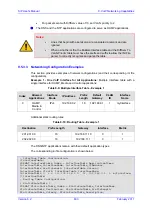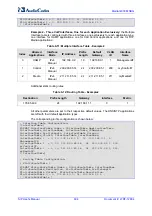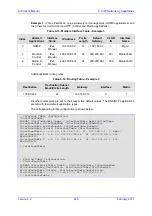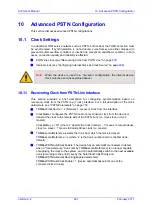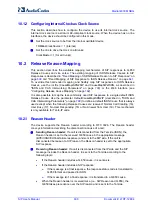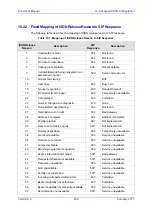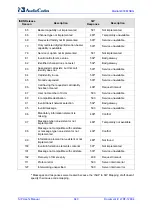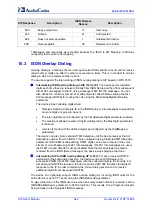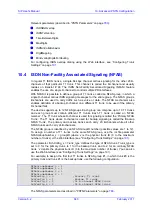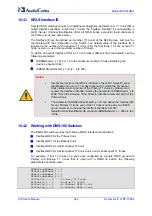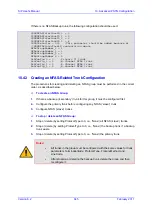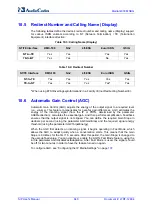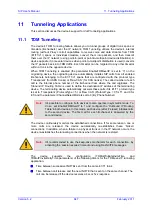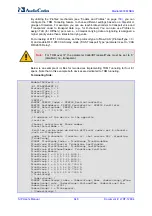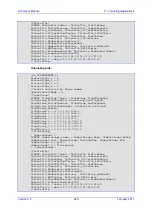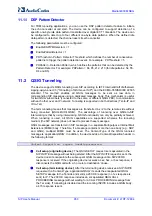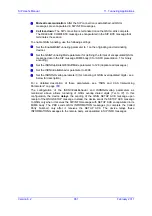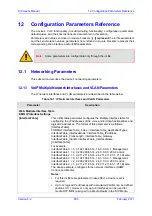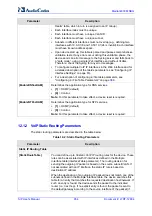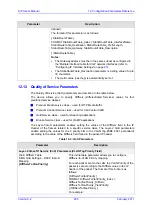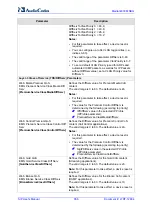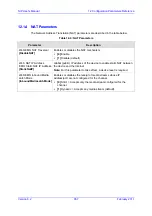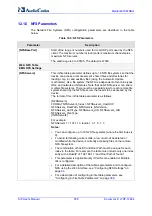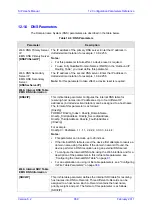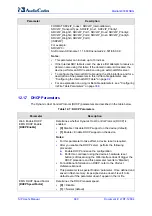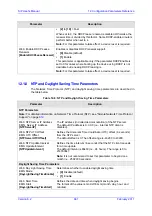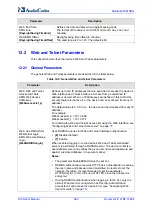
Version 6.2
647
February 2011
SIP User's Manual
11. Tunneling Applications
11 Tunneling
Applications
This section discusses the device's support for VoIP tunneling applications.
11.1 TDM Tunneling
The device's TDM Tunneling feature allows you to tunnel groups of digital trunk spans or
timeslots (B-channels) over the IP network. TDM Tunneling utilizes the device's internal
routing (without Proxy control) capabilities to receive voice and data streams from TDM
(E1/T1/J1/) spans or individual timeslots, convert them into packets, and then transmit
them over the IP network (using point-to-point or point-to-multipoint device distributions). A
device opposite it (or several devices when point-to-multipoint distribution is used) converts
the IP packets back into TDM traffic. Each timeslot can be targeted to any other timeslot
within a trunk in the opposite device.
When TDM Tunneling is enabled (the parameter EnableTDMoverIP is set to '1') on the
originating device, the originating device automatically initiates SIP calls from all enabled
B-channels belonging to the E1/T1/J1 spans that are configured with the protocol type
‘Transparent’ (for ISDN trunks) or ‘Raw CAS’ (for CAS trunks). The called number of each
call is the internal phone number of the B-channel from where the call originates. The
'Inbound IP Routing Table' is used to define the destination IP address of the terminating
device. The terminating device automatically answers these calls if its E1/T1 protocol type
is set to ‘Transparent’ (ProtocolType = 5) or ‘Raw CAS’ (ProtocolType = 3 for T1 and 9 for
E1) and the parameter ChannelSelectMode is set to 0 (By Phone Number).
Note:
It's possible to configure both devices to also operate in symmetric mode. To
do so, set EnableTDMOverIP to 1 and configure the 'Outbound IP Routing
Table' in both devices. In this mode, each device (after it's reset) initiates calls
to the second device. The first call for each B-channel is answered by the
second device.
The device continuously monitors the established connections. If for some reason, one or
more calls are released, the device automatically re-establishes these ‘broken’
connections. In addition, when a failure in a physical trunk or in the IP network occurs, the
device re-establishes the tunneling connections when the network is restored.
Note:
It's recommended to use the keep-alive mechanism for each connection, by
activating the ‘session expires’ timeout and using Re-INVITE messages.
The device supports the configuration (TDMoIPInitiateInviteTime and
TDMoIPInviteRetryTime parameters) of the following timers for the TDM-over-IP tunneling
application:
Time between successive INVITEs sent from the same E1/T1 trunk.
Time between call release and the new INVITE that is sent on the same channel. The
call can be released if the device receives a 4xx or 5xx response.
Содержание Mediant 800 MSBG
Страница 2: ......
Страница 366: ...SIP User s Manual 366 Document LTRT 12804 Mediant 800 MSBG Reader s Notes ...
Страница 372: ...SIP User s Manual 372 Document LTRT 12804 Mediant 800 MSBG Reader s Notes ...
Страница 390: ...SIP User s Manual 390 Document LTRT 12804 Mediant 800 MSBG Reader s Notes ...
Страница 404: ...SIP User s Manual 404 Document LTRT 12804 Mediant 800 MSBG Reader s Notes ...
Страница 616: ...SIP User s Manual 616 Document LTRT 12804 Mediant 800 MSBG Reader s Notes ...
Страница 636: ...SIP User s Manual 636 Document LTRT 12804 Mediant 800 MSBG Reader s Notes ...
Страница 652: ...SIP User s Manual 652 Document LTRT 12804 Mediant 800 MSBG Reader s Notes ...
Страница 886: ...SIP User s Manual 886 Document LTRT 12804 Mediant 800 MSBG Reader s Notes ...
Страница 890: ...User s Manual Ver 6 2 www audiocodes com ...

